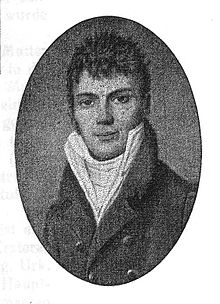Johann Heinrich Schervier
Johann Heinrich Schervier (born January 5, 1784 in Aachen ; † February 26, 1845 there ) was a German businessman , entrepreneur and politician .
Life
Johann Heinrich Schervier grew up as the 10th child of the citizen captain Johann Gerhard Schervier and his wife Maria Elisabeth, born. Thielen in Aachen . He learned the copper bat trade in his parents' company.
In 1807 his parents transferred the copper farm at Templergraben in Aachen, valued with a capital of 22,575 Reichsthaler , to him and his older brother Johann Josef and leased the "top two trees" of the Buschmühle to them. Together with Johann Adam Schleicher from Stolberg , who also came from an old copper master family, the brothers founded another company on the Buschmühle in Stolberg, to which Schleicher used his two court mills in Stolberg, the third part of his Galmeimühle and the Plutschhammer as an insert made his furnace houses available.
In the same year Johann Heinrich Schervier married Maria Gertrudis Theresia Priem . She died a year later after giving birth to her first daughter.
In 1811 he married a second time, now the French woman Maria Aloysia (Louise) Victoire Migeon from Charleville-Mézières , daughter of the local blacksmith, factory owner and later mayor Jean-Baptiste Migeon . They had six children.
With his brother-in-law Jean-Baptiste, his brother Jean Vincent Migeon and his brother Johann Josef Schervier, he founded the company " Migeon et Schervier frères " in the same year . The French brought in their Aachen sewing and pin factory "Migeon frères" in the Elfschornsteinstrasse house, known as " the Klosterrath Refugium ". This factory was founded in 1804 by the Aachen citizen Laurenz Jecker after he bought the former property of the Klosterrath Abbey, nationalized by Napoleon , for 13,000 francs. had acquired. The operation was now with the entire inventory and the machines with 130,900 frcs. rated. The Schervier brothers provided 180,000 francs. and brass wire from their Stolberg factory are available. The commercial management of the business was carried out by Johann Heinrich, also known as "Jean Henry" at the time, who provided a free apartment including operating costs and an annual salary of 2,400 francs. received in advance. His older brother Joseph supervised the construction of the tools, machines and workshops and received an annual salary of 1,200 frcs.
The company founded in Stolberg with Johann Adam Schleicher was liquidated before 1814 because Schleicher had no longer met his obligations.
After the fall of Napoleon and the advance of the Prussians, Johann Heinrich Schervier was appointed subordinate in the 2nd battalion of the city of Aachen on September 5, 1814 .
The Migeon brothers gradually withdrew from the business to France. In 1816 Jean Vincent left the company completely and the Schervier brothers took over two thirds of the factory property in Elfschornsteinstraße and the associated rights, which had previously belonged to the Migeon siblings alone.
In the fall of 1818, the Austrian Emperor Franz I visited the needle factory. He was also the godfather of their daughter Franziska, who was born on January 3, 1819 and was later beatified .
In 1823 Johann Heinrich Schervier paid off the remaining partners in full and the land and buildings became the sole property of his family. The former Kupferhof am Templergraben, inherited from his father, was converted into a cloth factory a few years later, in which the Hergett cloth factory was initially quartered in one wing from 1830 and the entire complex was divided up with the Marx & Auerbach cloth factory from 1839 .
From 1830 Schervier was honorary associate mayor of the city of Aachen .
In 1845, at the age of 59, he died of a "sticky river" after his wife had preceded him in 1832. Johann Heinrich Schervier found his final resting place in the family crypt in Aachen's Ostfriedhof .
literature
- Joseph Gerhard Rey: The Schervier family and their clans (= publications of the episcopal diocesan archive Aachen 1, ZDB -ID 846757-2 ). Johannes Volk Verlag, Aachen 1936.
- Hermann Friedrich Macco : Aachen coat of arms and genealogies. A contribution to the heraldry and genealogy of Aachen, Limburg and Jülich families. Aachener Verlags- und Druck-Gesellschaft, Aachen 1907, p. 116 .
- Eduard Arens, Wilhelm Leopold Janssen : Club Aachener Casino , new ed. by Elisabeth Janssen and Felix Kuetgens , printing Metz, Aachen 2nd edition 1964, p. 136
| personal data | |
|---|---|
| SURNAME | Schervier, Johann Heinrich |
| ALTERNATIVE NAMES | Schervier, Jean Henry |
| BRIEF DESCRIPTION | German entrepreneur |
| DATE OF BIRTH | January 5, 1784 |
| PLACE OF BIRTH | Aachen |
| DATE OF DEATH | February 26, 1845 |
| Place of death | Aachen |

